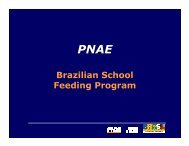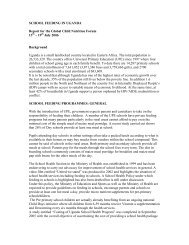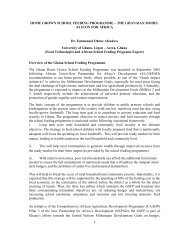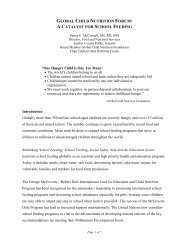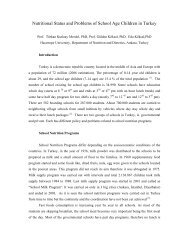EXECUTIVE SUMMARY - Global Child Nutrition Foundation
EXECUTIVE SUMMARY - Global Child Nutrition Foundation
EXECUTIVE SUMMARY - Global Child Nutrition Foundation
You also want an ePaper? Increase the reach of your titles
YUMPU automatically turns print PDFs into web optimized ePapers that Google loves.
Cape Verde<br />
Community education and capacity building will ensure<br />
the school feeding program’s sustainability.<br />
In 2006, Cape Verde decided to develop a national strategy<br />
for school feeding. The government established a national<br />
commission to implement the program. This commission<br />
monitors school feeding, prevents duplication of effort, and<br />
promotes coordination among the Health, Education, and<br />
Social Affairs Ministries.<br />
Community education is an important part of the country’s<br />
school feeding program. A campaign has begun that illustrates<br />
why program continuity is necessary. This community<br />
sensitization work will ensure the program’s sustainability over<br />
time.<br />
One of the major challenges highlighted was capacity. Even if<br />
a country has resources to support school feeding, it must also<br />
have the capacity to manage them. The WFP is currently<br />
providing technical assistance to Cape Verde in this area.<br />
Rwanda<br />
A national school feeding policy is integral to achieving<br />
Rwanda’s future economic goals.<br />
Rwanda’s school feeding program, funded by the WFP, has<br />
been implemented in 300 schools and benefits 300,000<br />
children. Now the country wants to transition to a nationally led<br />
school feeding program.<br />
Rwanda has developed a school nutrition policy that<br />
incorporates meals, school farming and gardening, nutrition<br />
Scaling Up Sustainability: Linking School Feeding with Agriculture<br />
Development to Maximize Food Security<br />
May 3-7, 2011<br />
Nairobi, Kenya<br />
© 2011 GCNF and PCD. All rights reserved. Page 26<br />
education, and water sanitation. This policy is aligned with the<br />
government’s Vision 2020, which seeks to transform Rwanda<br />
into a middle-income country.<br />
In addition to providing strategic direction, the school feeding<br />
policy also informs planning and prevents duplication of effort<br />
by stakeholders. One of the challenges facing Rwanda,<br />
however, is school feeding program sustainability. Looking<br />
ahead, 70% of the school feeding budget must come from the<br />
community.<br />
Malawi<br />
School feeding is well integrated into Malawi’s national<br />
policies, but greater interaction is needed with local<br />
agricultural markets.<br />
Malawi’s school feeding strategy began in 1995. Based on<br />
positive results, a Presidential Directive was issued to expand<br />
the program to rural areas.<br />
Today, the school feeding program is guided by the National<br />
<strong>Nutrition</strong> Policy. School feeding has also been integrated into<br />
Malawi’s Growth Strategy and the National Education Sector<br />
Plan. Four key areas of concern regarding the school feeding<br />
program are cost containment, sustainability, financial<br />
security, and an implementation roadmap.<br />
Looking ahead, agricultural markets must be linked to school<br />
feeding programs. Home grown school feeding programs can<br />
provide new opportunities for smallholder farmers. Increased<br />
agricultural production is the focus of Malawi’s agriculture<br />
program and its participation in the CAADP compact.



